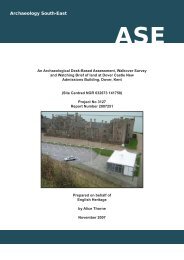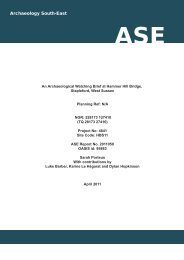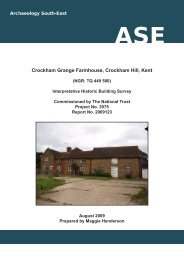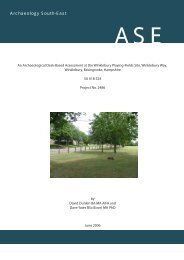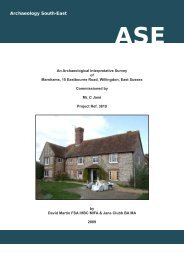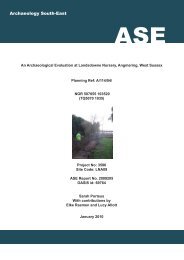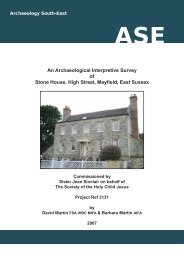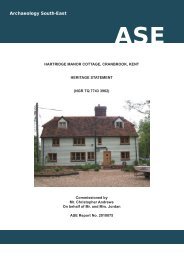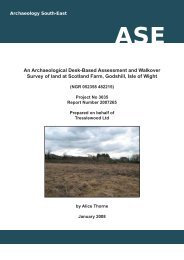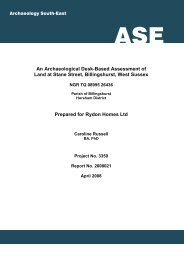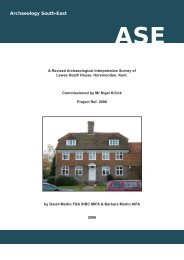ASE front cover - Archaeology South-East
ASE front cover - Archaeology South-East
ASE front cover - Archaeology South-East
You also want an ePaper? Increase the reach of your titles
YUMPU automatically turns print PDFs into web optimized ePapers that Google loves.
<strong>Archaeology</strong> <strong>South</strong>-<strong>East</strong>2008058: Holbury Infants School, Holbury, Hampshire(plain tile).T1Clean orange clay matrix with some lighter banding and moderate tocommon fine quartz; moderate dark-red iron-rich clay and sparse coarsequartz and fine white calcareous inclusions. Well-sorted fine quartz mouldingsand.5.2.10 Discussion5.2.10.1 The analysis of the Roman fabrics suggests that approximately 85% of thetiles reflect a similar geology of orange-firing marl clays. This lack of varietyprobably indicates a local source for most of the material, with the possibleexception of fabric R3. Perhaps surprisingly, there is no trace of thedistinctive group of calcareous tiles found widely on later Roman sites alongthe south and south-east coasts of Britain in the later 2nd and 3rd centuries(Betts and Foot 1994, 31-2). The significance of this is not clear, but it couldbe connected with the status or function of the site.5.2.10.2 The paucity of imbrices and flue tiles suggests that the assemblage doesnot represent primary deposition of destruction debris from the roof orhypocaust of a villa. The composition of the assemblage, in which morethan 95% is bricks and tegulae, suggests rather that flat tiles have beenselected for re-use on the site.5.2.10.3 The quantity of reduced and vitrified brick and tile, from probable quarry pits[1004] and [1009], and small pit [1043] could indicate that the material hasbeen used for some sort of industrial process involving hearths, kilns orovens.5.3 Prehistoric FlintworkChris Butler5.3.1 A single piece of worked flint weighing 54gms was re<strong>cover</strong>ed from [1077],the secondary fill of slot [1075] of linear A.5.3.2 It is a small honey-coloured flint nodule with buff cortex, which has beenutilised as a core. A flake has been removed to create a single platform,from which a series of small flakes have been removed from around 50% ofits circumference. There is no evidence of any platform preparation, and thecore had been abandoned due to plunging flakes, which meant that nofurther flakes could be sensibly removed.5.3.3 It is probably Later Neolithic or Early Bronze Age in date, possibly later andis most likely residual within the upper fill of [1075].5.4 Waterlogged WoodLucy Allott5.4.1 Four pieces of waterlogged wood were collected from [1023], a fill within apit [1009] (Figure 6). They were cleaned of the surrounding clay matrix,measured, as detailed in table 8, with any evidence of working noted.Where possible identifications have be made with reference to comparativematerial in wood anatomy atlases (Hather 2000, Schweingruber 1990).29© <strong>Archaeology</strong> <strong>South</strong>-<strong>East</strong>



